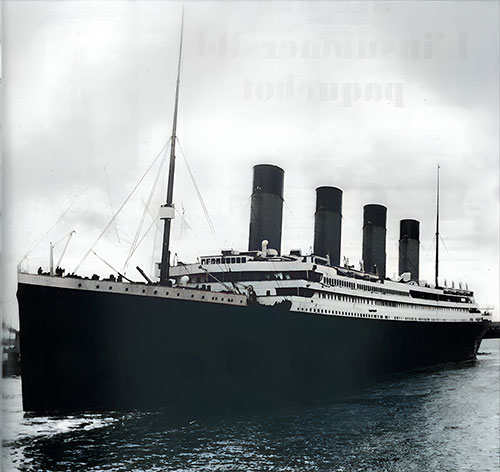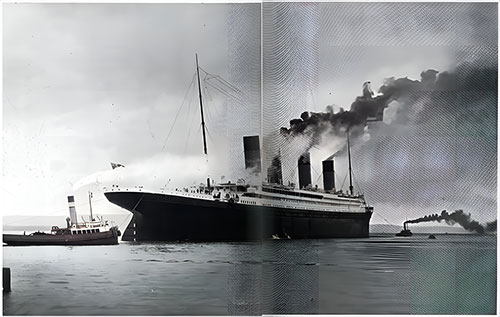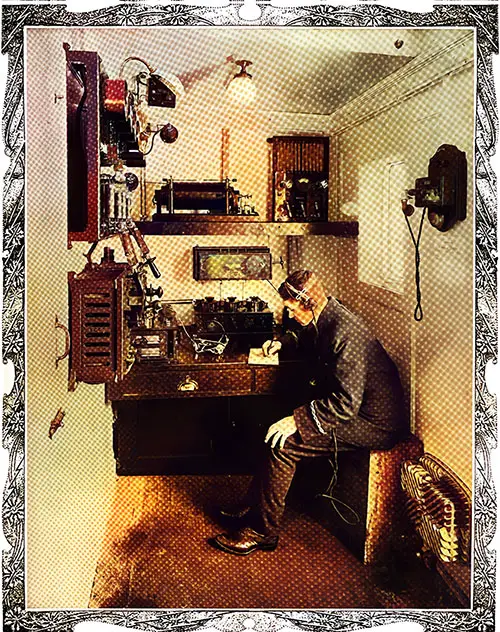The Titanic’s Construction and Launch: Engineering, Innovation, and Oversight
📌 Explore the Titanic’s planning, construction, and launch, from keel laying to its maiden voyage. Learn about its engineering marvels, luxurious interiors, and structural flaws. A valuable resource for students, teachers, historians, and genealogists researching maritime history and transatlantic travel.

The RMS Titanic, photo taken during her sea trials circa 1912. GGA Image ID # 103a5a990e
The Planning, Building, and Launching of the Titanic 🚢🏗️
The "Planning, Building, and Launching the Titanic" section presents a detailed, step-by-step account of how the world’s most famous ocean liner came to life—from the drawing board to its ill-fated maiden voyage. This collection of articles covers every aspect of Titanic’s design, engineering, and grandeur, while also examining the technological and safety shortcomings that contributed to its tragic sinking.
🌍 Who Should Use This Resource?
✅ Teachers & Students – Excellent for history, STEM, and social studies essays
✅ Genealogists – Understand the world in which Titanic’s passengers and crew lived
✅ Historians – Study maritime advancements and Edwardian-era shipbuilding
✅ Maritime Enthusiasts – Explore the engineering and opulence of Titanic
📌 For students writing essays on maritime history, engineering, or social class aboard the Titanic, this resource provides primary sources, technical details, and rich historical context.
The keel of the Titanic was laid on March 31, 1909, and she was launched on May 31, 1911. She passed her trials before the Board of Trade officials on March 31, 1912, at Belfast, arrived at Southampton on April 4, and sailed the following Wednesday, April 10, with 2,208 passengers and crew on her maiden voyage to New York.
She called at Cherbourg the same day, Queenstown Thursday. She left for New York in the afternoon, expecting to arrive the following Wednesday morning. The RMS Titanic never completed the voyage.
She collided with an iceberg on Sunday at 11.45 p.m. in Lat. 41° 46' N. and Long. 50° 14' W. and sank two hours and a half later; 815 of her passengers and 688 of her crew were drowned, and 705 were rescued by the Carpathia." Such is the record of the Titanic, the largest ship the world had ever seen.

The Decks of the Titanic: A Comprehensive Guide to Ship Design & Accommodations
The "Decks of the Titanic - Comprehensive Details" offers an in-depth architectural and structural analysis of the world’s most infamous ocean liner. Extracted from the 1912 Congressional Serial Set on the Loss of the Titanic, this document provides one of the most thorough descriptions available of the ship’s:
✅ Watertight compartments and bulkheads
✅ Deck-by-deck breakdown of accommodations
✅ Safety measures and shipboard communication systems
✅ Passenger access routes to the lifeboats
📌 For teachers, students, genealogists, and historians, this is an exceptional resource, not only for understanding the Titanic’s construction and safety failures but also for examining Edwardian-era maritime design and social class distinctions aboard transatlantic liners

The Titanic: Engineering Marvel or Doomed Giant? A Detailed Ship Description
The "Description of the Titanic" provides an extensive breakdown of the ship’s technical specifications, structural design, and ownership details, drawn from the 1912 Congressional Serial Set report on the Loss of the Titanic. This article is invaluable for:
✅ Historians studying maritime safety and shipbuilding advancements
✅ Genealogists researching White Star Line passengers & crew
✅ Educators and students exploring the Titanic’s impact on history
✅ Maritime enthusiasts interested in the ship’s revolutionary design and tragic failure
📌 Built as the largest and most advanced ocean liner of its time, Titanic’s luxury, engineering prowess, and White Star Line dominance in transatlantic travel were overshadowed by its infamous sinking on its maiden voyage. This comprehensive analysis of Titanic’s construction exposes both its strengths and fatal weaknesses.

Titanic’s Engine Room: The Power & Engineering Behind a Maritime Legend
The "Machinery of the Titanic" article provides a meticulous breakdown of the ship’s engineering marvels, from its colossal boilers and reciprocating engines to its advanced condensing systems and bilge pumps. For those fascinated by maritime technology, this article is an indispensable resource that explains how the ship’s powerful but flawed engineering contributed to its legacy and disaster.
Who Should Read This? 🎯
✅ Historians & maritime scholars – Study Titanic’s engineering innovations & vulnerabilities
✅ Teachers & students – Use this as a STEM case study on early 20th-century engineering
✅ Genealogists & researchers – Understand the conditions engineers & stokers faced
✅ Titanic enthusiasts – Dive into the technical side of the ship beyond luxury & tragedy

Marconi & the Titanic: How Wireless Telegraphy Changed Maritime Safety Forever
The article "Master of Wireless – Guglielmo Marconi" is a compelling exploration of how wireless telegraphy transformed ocean travel and emergency response, particularly in the Titanic disaster. It examines Marconi’s groundbreaking work, the Titanic’s distress signals, and the regulatory changes that followed.
📌 This is a must-read for historians, students, and maritime researchers, as it contextualizes one of the most pivotal technological advancements in maritime history.

Navigating the Titanic: A Sectional View & Ship’s Directory of the World’s Largest Ocean Liner
The article "Sectional View and Ship's Directory of the Titanic" offers a fascinating glimpse into the design, layout, and infrastructure of the largest ship of its time. It provides detailed insights into the Titanic’s decks, amenities, and the significant improvements made to its sister ship, Olympic, after the disaster.
📌 This article is an invaluable resource for teachers, students, genealogists, and historians, as it provides a blueprint of Titanic’s internal structure, revealing the luxuries, safety measures, and fatal design flaws that played a role in the disaster.
NOTE: This is where you will find the popular Deck Plans of Boat Deck and Decks A-D of the RMS Titanic Including Placement of Lifeboats With You Are Here Insert. The most popular download of all images on the GG Archives website.

The Structure of the Titanic: Engineering Marvel & Fatal Design Flaws
The article "Structure of the Titanic" provides an in-depth technical analysis of the ship’s design, including its steel framework, watertight compartments, electrical installations, pumping systems, and life-saving appliances. This detailed blueprint of Titanic’s construction allows historians, students, genealogists, and maritime enthusiasts to understand both the ship’s engineering marvels and the flaws that led to its sinking.
📌 This article is a goldmine for educators and researchers who wish to explore the balance between innovation and oversight in shipbuilding, offering lessons in maritime safety, emergency preparedness, and technological advancement.

Titanic: A Floating Palace – The Luxurious Appointments & Ill-Fated Grandeur
The "Titanic – A Floating Palace" article offers a remarkable glimpse into the Titanic’s unmatched luxury and grandeur, providing a detailed account of its lavish first-class accommodations, recreation spaces, and groundbreaking amenities.
This historical analysis is essential for:
✅ Historians studying Edwardian luxury and maritime advancements
✅ Students & teachers exploring class distinctions aboard Titanic
✅ Genealogists seeking insights into passenger experiences
✅ Maritime enthusiasts fascinated by the Titanic’s engineering & design
📌 Before its tragic sinking, the Titanic symbolized the peak of oceanic luxury—a floating city where the richest travelers in the world enjoyed an experience rivaling the finest hotels. However, despite its unsinkable reputation, flawed safety measures and overconfidence led to its demise.

Wireless Telegraphy in the Titanic Era: The Lifesaving Technology That Changed Maritime History
The article "Wireless Telegraphy Used in the Titanic Era" explores the revolutionary impact of wireless communication on maritime safety, particularly its role in the Titanic disaster. It details the development of radio signals like CQD and SOS, the pioneering work of Guglielmo Marconi, and how wireless technology shaped the future of ocean travel.
This article is a must-read for students, teachers, genealogists, and historians interested in:
✅ The history of wireless communication
✅ The role of Marconi’s invention in saving lives
✅ How radio became a mandatory safety feature on passenger ships
📌 For students writing essays on Titanic, maritime safety, or technological advancements, this article provides rich historical context and primary sources to support research.
The Titanic’s Journey: From Blueprint to Maiden Voyage
📜 Most Engaging Image:
🔹 "The RMS Titanic, photo taken during her sea trials circa 1912" – A powerful snapshot of the Titanic in motion, just days before its ill-fated journey.
💡 Why It Matters:
Seeing the Titanic fully operational and at sea before the disaster brings a haunting realism to the tragedy.
🚢 Deck-by-Deck Breakdown: Titanic’s Interior & Safety Features
📜 Most Engaging Image:
🔹 "Plate 3: Plans for Boat Deck and Promenade Deck" – A highly detailed blueprint of Titanic’s layout, safety features, and passenger access routes.
💡 Why It Matters:
🔹 This deck plan is invaluable for understanding how the ship was structured.
🔹 Highlights the locations of lifeboats, which played a crucial role in the survival rates of passengers.
🔹 Explores how different social classes were divided aboard the ship.
📌 For historians and educators, this deck-by-deck breakdown is essential for examining Titanic’s design strengths and safety failures.
🏗️ Titanic: Engineering Marvel or Doomed Giant?
📜 Most Engaging Image:
🔹 "The Biggest Ship in the World Which Met Disaster on Her Maiden Voyage" – A grand illustration of Titanic’s scale and construction.
💡 Why It Matters:
🔹 Titanic was the most advanced passenger liner of its time.
🔹 Its size, luxury, and speed symbolized an era of maritime supremacy.
🔹 But its structural shortcomings contributed to its catastrophic sinking.
📌 For students writing about Titanic’s technological advancements, this section explores how innovation met disaster.
🔥 Titanic’s Engine Room: Power, Pressure & Disaster
📜 Most Engaging Image:
🔹 "Boilers on the RMS Titanic" – A close-up of the ship’s massive power system.
💡 Why It Matters:
🔹 Titanic’s triple-expansion engines and turbine technology were state-of-the-art.
🔹 The ship’s reliance on coal-powered boilers played a role in its operational efficiency—and its dangers.
🔹 A detailed look at the mechanical systems that kept Titanic moving.
📌 For STEM students, this section is a great case study in early 20th-century engineering.
📡 Wireless Telegraphy: The Titanic’s Last Call for Help
📜 Most Engaging Image:
🔹 "Signor Guglielmo Marconi - The Scientist Whose System of Telegraphy Brought Help to the Titanic" – A tribute to the man whose invention saved over 700 lives.
💡 Why It Matters:
🔹 Wireless radio was still a new technology, but it played a crucial role in Titanic’s final moments.
🔹 CQD and SOS distress signals were broadcast by Titanic’s radio operators until the ship vanished beneath the waves.
🔹 The Carpathia responded thanks to Marconi’s system, proving that wireless technology was essential for maritime safety.
📌 For students studying communications history, this section provides an excellent case study on technological evolution in emergency response.
🔍 Inside Titanic: A Sectional View of the World's Largest Ocean Liner
📜 Most Engaging Image:
🔹 "The Biggest Ship in the World Shown in Section" – A technical cutaway revealing Titanic’s internal structure.
💡 Why It Matters:
🔹 A rare glimpse inside Titanic’s complex layout, from its luxurious accommodations to its engine rooms.
🔹 Highlights the critical design flaws that led to rapid flooding after the iceberg collision.
🔹 Comparisons to its sister ship, Olympic, reveal how Titanic’s sinking influenced future shipbuilding improvements.
📌 For researchers and maritime scholars, this section offers a visual blueprint of the Titanic’s grand scale and tragic vulnerabilities.
🏛️ Titanic’s Structure: Strengths, Flaws, and the Legacy of Its Design
📜 Most Engaging Image:
🔹 "Titanic Outboard Profile, Boat Deck and Orlop Deck Plans" – A complete profile of the Titanic from hull to mast.
💡 Why It Matters:
🔹 Titanic was built for luxury, not disaster—and this section explores its engineering triumphs and miscalculations.
🔹 How the double-bottom hull worked (and failed) under extreme stress.
🔹 The absence of a continuous watertight deck, which contributed to the ship’s rapid sinking.
📌 For teachers and students exploring engineering mistakes, this is an essential case study in design oversight.
🛳️ Titanic: A Floating Palace of Luxury & Class Distinctions
📜 Most Engaging Image:
🔹 "The Palatial Appointments of the Ocean Liner Titanic" – A stunning image capturing the opulence of Titanic’s first-class interiors.
💡 Why It Matters:
🔹 Titanic was a microcosm of Edwardian society—a floating city where luxury and poverty coexisted.
🔹 The ship’s interior rivaled the world’s best hotels, with fine dining, a gym, swimming pool, and Turkish baths.
🔹 But in a disaster, wealth meant survival—first-class passengers had greater access to lifeboats.
📌 For historians studying class differences, Titanic offers a stark lesson in privilege and survival.
📖 Need Sources for an Essay? Use This Collection!
📚 For Students:
🔹 Explore Titanic’s construction and safety failures.
🔹 Analyze the role of wireless communication in the disaster.
🔹 Compare Titanic’s engineering flaws to modern shipbuilding standards.
🔎 Key Questions for Research:
🔹 How did Titanic’s structural design contribute to its rapid sinking?
🔹 What role did Marconi’s wireless telegraphy play in the rescue efforts?
🔹 How did Titanic’s class divisions affect survival rates?
⚡ Explore More on Titanic’s Design, Luxury, and Legacy!
🚀 Use these materials for essays, projects, and deep historical research!
📖 Looking for more Titanic history? Browse the GG Archives for exclusive ship plans, first-hand accounts, and technical analyses!
